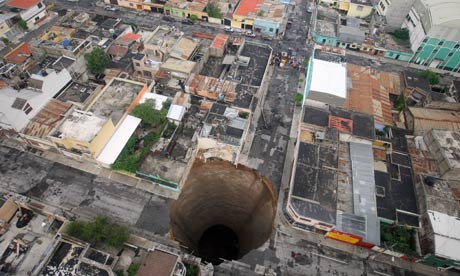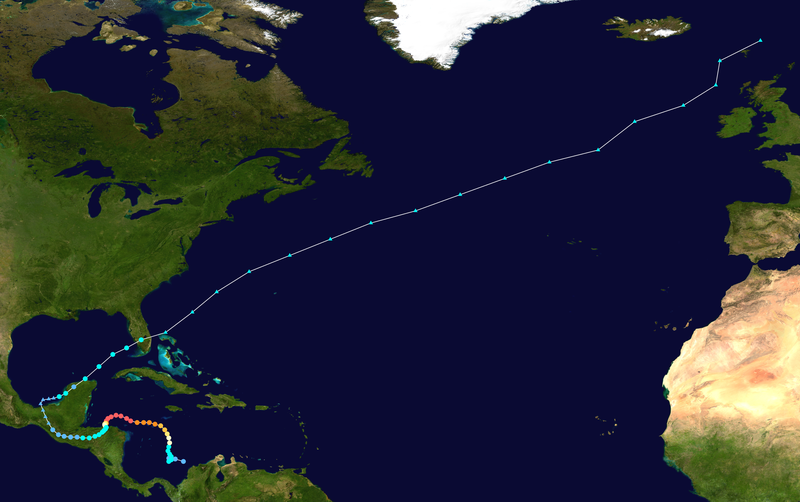Consecuences: evacuation, transport, education, flights, agriculture, alert, no energy, earthquakes.
The damage caused in Guatemala was ash all over the city and death to nearby towns. The most affected areas where: Escuintla, Santa Elena Barillas, Villa canales, San Miguel Petapa, Villa nueva and Amatitlán.
This volcano "attack" affect mostly because it caused the death of loved one´s, and the distruction of homes.

 This storm made many children suffer, because the lost their homes and part of their family.
This storm made many children suffer, because the lost their homes and part of their family. many people fell in that hole and died that day.
many people fell in that hole and died that day.
Hurricane Mitch was the most powerful hurricane of the 1998 Atlantic hurricane season, with maximum sustained winds of 180 mph. The storm was the thirteenth tropical storm, ninth hurricane, and third major hurricane of the season. At the time, Hurricane Mitch was the strongest Atlantic hurricane observed in the month of October, though it has since been surpassed by Hurricane Wilma of the 2005 season. The hurricane matched the fourth most intense Atlantic hurricane on record.
Mitch formed in the western Caribbean Sea on October 22, and after drifting through extremely favorable conditions, it rapidly strengthened to peak at Category 5 status, the highest possible rating on the Saffir-Simpson Hurricane Scale. After drifting southwestward and weakening, the hurricane hit Honduras as a minimal hurricane. It drifted through Central Amercia, reformed in the Bay of Campeche, and ultimately struck Florida as a strong tropical storm.
Due to its slow motion from October 29 to November 3, Hurricane Mitch dropped historic amounts of rainfall in honduras, Guatemala, and Nicaragua, with unofficial reports of up to 75 inches. Deaths due to catastrophic flooding made it the second deadliest Atlantic hurricane in history; nearly 11,000 people were killed with over 11,000 left missing by the end of 1998. As of 2008, the official death toll from Mitch was placed at 19,325, with thousands more unaccounted for. Additionally, roughly 2.7 million were left homeless as a result of the hurricane. The flooding caused extreme damage, estimated at over $5 billion. The origin of Hurricane Mitch can be traced to a tropical wave that moved off the coast of Africa on October 10. It moved westward across the shear-ridden Atlantic Ocean, and remained disorganized until entering the Carobbean Sea on October 18. Upon entering the western Caribbean Sea,convection steadily increased, and on October 22, the wave organized into Tropical Depression Thirteen while 415 miles south of Kingston, Jamaica. Under weak steering currents, it drifted westward and intensified into a tropical storm on October 23 while 260 miles east-southeast of San Andrés Island.
The origin of Hurricane Mitch can be traced to a tropical wave that moved off the coast of Africa on October 10. It moved westward across the shear-ridden Atlantic Ocean, and remained disorganized until entering the Carobbean Sea on October 18. Upon entering the western Caribbean Sea,convection steadily increased, and on October 22, the wave organized into Tropical Depression Thirteen while 415 miles south of Kingston, Jamaica. Under weak steering currents, it drifted westward and intensified into a tropical storm on October 23 while 260 miles east-southeast of San Andrés Island.
Initially, intensification was limited due to upper-level low causing vertical wind shear over Tropical Storm Mitch. As the storm executed a small loop to the north, the shear weakened, allowing the system to strengthen. Mitch attained hurricane status on October 24 while 295 miles south of Jamaica, and with warm water temperatures and well-defined outflow, the hurricane rapidly strengthened. During a 48-hour period from October 23 to the 25th, the central pressure dropped 52 mbar, and on October 26, Mitch reached peak intensity with 180 mph winds and a pressure of 905 mbar, one of the lowest pressures ever recorded in an Atlantic Hurricane.


No comments:
Post a Comment